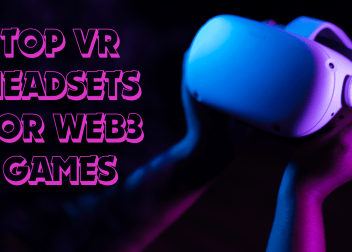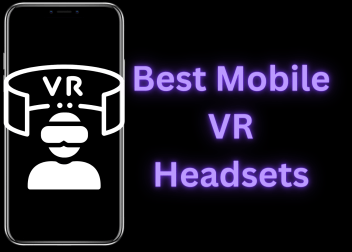Buy AR and VR Headsets Which Fits You The Best!
The AR and VR headsets market is witnessing increased competition, with major players like Google and Microsoft launching their own devices, leading to a dilemma for first-time buyers. We have already covered how AR and VR have been making waves in the gaming world, which you can check out here: AR and VR in Gaming, now we’ll be talking about some of the best headsets so you can get the best AR and VR experience in your games.
The overall market for AR and VR headsets is poised for substantial growth, with projections indicating a significant increase in shipments from 13.7 million units in 2017 to over 81 million units by 2021, a growth of over 56%. Established players in the market include Playstation VR, Oculus Rift, and HTC Vive, but Apple’s introduction of devices with built-in ARkit and the widespread adoption of ARcore in Android phones are expected to further propel the market. Virtual and Augmented Reality are anticipated to become integral parts of daily life, assisting in various activities, and already, 75% of Forbes’ largest companies have invested in this technology.
Best AR and VR Headsets:
MIRA PRISMPros:
Cons:
|
Microsoft Hololens 2Pros:
Cons:
|
Google CardboardPros:
Cons:
|
HTC VivePros:
Cons:
|
Oculus RiftPros:
Cons:
|
MIRA PRISM:
The Mira Prism Augmented Reality (AR) Headset offers a compelling entry into the world of AR with a Bottom Line Up Front (BLUF) that highlights both its strengths and limitations. Priced at an affordable $150 USD, the Mira Prism focuses on untethered AR experiences, utilizing a mesh-screen system and magnets for lens attachment, creating a sleek and user-friendly design.
One standout feature is the impressive 60-degree Field of View (FoV), surpassing competitors like Microsoft HoloLens and Magic Leap. This wide FoV enhances the immersive experience, filling the user’s forward-looking field of view. Transitioning between the AR environment and the real world is seamless, allowing users to interact with both effortlessly.
However, the Mira Prism has its drawbacks. The headset tends to be front-heavy, causing discomfort during prolonged use. Adjusting the balance becomes crucial to prevent sliding or tight strapping-induced headaches. Additionally, compatibility is limited to iPhone 6, 6S, 7, and 8, restricting its user base.
The hardware package includes a stereo camera rig, magnetically attachable lens, 3 Degrees of Freedom (3 DoF) remote control, and a well-designed carrying case. The development environment relies on Unity and XCode, offering a standard but somewhat limited Integrated Development Environment (IDE). While the Mira SDK supports Wikitude Computer Vision for various tracking features, the documentation is slightly outdated, making troubleshooting challenging.
One of the standout aspects of Mira Prism is its affordability, making it an excellent choice for AR development beginners or those looking to quickly prototype concepts. The platform’s integration with Unity, Gyroscope-based rotational tracking, counter-distortion rendering, and a 3 DoF Bluetooth controller enhance its capabilities. However, potential users should be aware of licensing fees for deployments and the headset’s limited compatibility with specific iPhone models.
Microsoft Hololens 2:
The Microsoft HoloLens 2 emerges as a cutting-edge augmented reality (AR) headset, promising an immersive AR experience through a range of sophisticated features. The device boasts see-through holographic lenses (waveguides) for a visually engaging experience with 2k 3:2 light engines and a holographic density exceeding 2.5k radiants. Eye-based rendering enhances display optimization for 3D eye position.
Equipped with advanced sensors, the HoloLens 2 integrates head tracking, eye tracking, and an Azure Kinect sensor, facilitating real-time hand tracking and eye tracking. The device ensures world-scale positional tracking and spatial mapping for a comprehensive AR experience. The Qualcomm Snapdragon 850 Compute Platform and a 2nd generation custom-built holographic processing unit (HPU) contribute to the device’s computational capabilities.
In terms of audio and speech features, the HoloLens 2 features a 5-channel microphone array and built-in spatial audio, enhancing the immersive quality of the AR experience. The inclusion of Dynamics 365 suite integration and the Windows Holographic Operating System further positions the HoloLens 2 as a comprehensive AR solution.
The unboxing experience is meticulously detailed, providing insight into the package contents. The HoloLens 2 package includes essentials such as the device itself, a stylish carrying case, an overhead strap, a microfiber cloth, a charger, and a USB-C cable. The elegant black carrying case adds a touch of sophistication and practicality to the overall presentation.
In terms of design, the HoloLens 2 impresses with an elegant and professional appearance. The device is smaller and lighter than anticipated, featuring premium quality materials and fabric finishes. The ergonomic headband, coupled with a weight distribution strap, ensures comfort during prolonged use. Its professional aesthetic makes it well-suited for deployment in enterprise settings.
Google Cardboard:
Google Cardboard may seem like a playful entry into the virtual reality (VR) space, but its simplicity and affordability serve a crucial role in introducing the masses to VR. Priced at a mere $30, this cardboard phone case, equipped with glass lenses and a corresponding app, transforms Android and iOS smartphones into VR viewers. While lacking the sophistication of high-end competitors like Oculus and Vive, Google Cardboard provides an accessible and entertaining VR experience for nearly anyone.
The true value of Google Cardboard lies in its democratization of VR technology. Amidst a landscape where competitors demand substantial financial investments, Google Cardboard emerges as a dirt-cheap alternative, making VR accessible to curious users willing to explore the potential of virtual reality without breaking the bank. The experience is app-driven, with offerings like Adult Swim’s Virtual Brainload VR app providing immersive, albeit brief, encounters with psychedelic visuals and sounds.
Sharing the Cardboard experience, much like passing along a box of popcorn, emphasizes its social and introductory nature. Although its hardware may have minor imperfections, such as a flimsy trigger mechanism, the concept of Cardboard is deemed perfect for its role as a gateway into VR. While it may lack the advanced features of high-end VR headsets, Cardboard serves as an entry point, allowing users to understand the possibilities and limitations of VR technology before investing in more complex systems.
Despite its limitations, Google Cardboard remains a practical and cost-effective introduction to VR, especially for those who want to dip their toes into the virtual realm without committing to pricier options. It acts as a precursor, paving the way for broader adoption and understanding of VR technology, bridging the gap between casual users and the more sophisticated experiences offered by premium VR hardware.
HTC Vive
The HTC Vive, with its immersive and groundbreaking virtual reality (VR) experience, stands out as the best on the market for those with a substantial budget. Launched in 2016, it quickly became a pioneer in consumer VR technology, offering unparalleled experiences. Boasting intuitive controls and a software partnership with Valve, the Vive provides a top-tier VR encounter. However, it comes with a relatively high price tag, demands a high-end GPU, and is considered less comfortable than some competitors like the Oculus Rift.
Over the years, the VR landscape has evolved, introducing various headset options catering to different preferences and budgets. Despite the advancements in the VR market, the HTC Vive remains a solid option for those embarking on their VR journey, although it’s worth noting that it’s a few years older than newer models entering the market. While HTC plans to release a new wireless, standalone VR headset in 2021, signaling a potential shift in focus, the original Vive is still available through third-party sellers and tech retailers.
Currently priced around $499 / £499 (about AU$615), the HTC Vive system includes the headset, controllers, earbuds, and base stations. However, it is essential to consider the additional cost of a computer with the recommended specs, as the Vive is not a standalone headset like the Oculus Quest 2. Despite being pricier than some alternatives, such as the Oculus Quest 2, which is lauded for its convenience and affordability, the HTC Vive continues to offer a high-end VR experience for those willing to invest in the technology.
As VR systems gain popularity, the HTC Vive remains a compelling option, combining its legacy as an early leader in VR with a more accessible price point, making it a viable choice for enthusiasts exploring the immersive world of virtual reality.
Oculus Rift:
The Oculus Rift, a leading virtual reality (VR) headset, delivers an immersive experience that has only improved with the inclusion of the Oculus Touch motion controllers. Compatible with both Oculus and SteamVR platforms, the Rift has positioned itself as a strong contender in the VR market. The bundle, featuring both the headset and controllers, has seen a significant price reduction, now available at $399, making it an appealing choice compared to pricier alternatives like the HTC Vive.
To fully unlock the Rift’s capabilities, users need to meet official requirements, including an Intel i5-4590 or better CPU, an Nvidia GTX 970 or AMD Radeon R9 290 or better video card, at least 8GB of RAM, an HDMI 1.3 output, and specific USB ports. The inclusion of Oculus Touch controllers adds a natural and comfortable control scheme, bringing the Rift in line with competitors like the HTC Vive. The headset itself features a simple and understated design, marked by a black rectangular visor with rounded edges.
Setting up the Oculus Rift is straightforward, involving downloading the Oculus setup software and following a few steps to connect the headset and sensors to the computer. The Oculus Touch controllers, Xbox One wireless controller, and Oculus Remote provide versatile control options, catering to various gameplay preferences. The inclusion of motion controls with the Touch controllers enhances the overall VR experience, bringing the Rift on par with competitors offering similar features.
While the Oculus Rift may lack the convenience of standalone VR systems like the PlayStation VR, its affordability, Oculus Touch controllers, and support for whole-room VR make it an Editors’ Choice for PC-tethered headsets. With the ability to work with both Oculus and SteamVR platforms, the Rift offers a versatile and appealing VR solution for users with compatible hardware.
Conclusion:
Choosing the best AR and VR headsets depends on individual preferences and needs. For augmented reality, Apple’s ARKit and Google’s ARCore offer accessible experiences on mobile devices. In the virtual reality realm, the HTC Vive stands out for its immersive experience, while the Oculus Rift provides a compelling PC-tethered option. Affordable choices like Google Cardboard bring VR to a broader audience. Ultimately, the ideal headset varies based on factors such as budget, platform compatibility, and desired features, reflecting the diverse landscape of augmented and virtual reality technologies.







